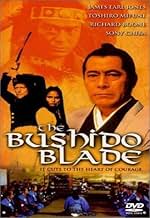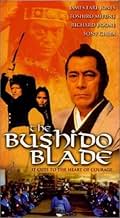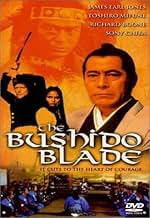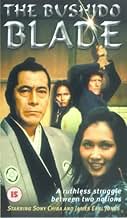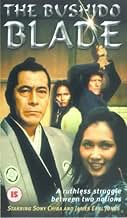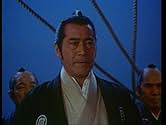Adicionar um enredo no seu idiomaA steel samurai blade that was to be given to the American ambassador by the Emperor of Japan is stolen. American sailors and Japanese samurai are sent to find it.A steel samurai blade that was to be given to the American ambassador by the Emperor of Japan is stolen. American sailors and Japanese samurai are sent to find it.A steel samurai blade that was to be given to the American ambassador by the Emperor of Japan is stolen. American sailors and Japanese samurai are sent to find it.
Mike Starr
- Bos'n Cave Johnson
- (as Michael Starr)
Timothy Patrick Murphy
- Midshipman Robin Burr
- (as Timothy Murphy)
Shin'ichi Chiba
- Prince Ido
- (as Sony Chiba)
Hitoshi Ômae
- Sumo
- (as Kin Omai)
Avaliações em destaque
A co-production between Japan and U.S. company Rankin/Bass, THE BUSHIDO BLADE (1979) was an attempt to capitalize on a growing interest in Japanese history which culminated the following year in the successful 'Shogun' TV miniseries and the English-dubbed samurai film, SHOGUN ASSASSIN, a re-edit of two films from the Japanese 'Lone Wolf and Cub' series. THE BUSHIDO BLADE, however, was the wrong film at the right time, despite the fact that it was shot in Japan with a mixed cast of American actors and Japanese stars. A fanciful account of Americans in Japan in 1854, it was ultimately undone by its low budget, lack of excitement, and contrived script.
It's set at the time of Commodore Matthew C. Perry's second trip to Japan, in February 1854, and his attempt to get a signed treaty with the Shogun. The basic plot borrows more than a little from the 1972 samurai western, RED SUN, and has to do with the theft of a sword intended for the U.S. president by a Japanese faction opposed to the treaty. Acting without orders, three Americans--a marine captain and two sailors, one of whom speaks a little Japanese--go off in pursuit of the sword and have numerous encounters in the Japanese countryside before the big confrontation at the castle of Lord Yamato, the nobleman behind the theft of the blade.
Quite improbably, the Americans encounter more than a few Japanese--five in all--who happen to speak adequate English, one of whom, Enjiro (played by Japanese-American actor Mako), is based on an actual historical figure, the fisherman Manjiro, who had been shipwrecked and taken to America some years earlier, but who actually had no interaction with the Americans during Perry's second trip. The other Japanese characters are all rather unlikely candidates to be proficient English speakers in 1854 Japan, but they include some big name actors. Toshiro Mifune (YOJIMBO) plays the Shogun's Commander; Sonny Chiba (THE STREET FIGHTER) plays Prince Ido, a foe of Yamato; and Tetsuro Tamba (YOU ONLY LIVE TWICE) plays Lord Yamato. Laura Gemser seems to have wandered in from Italian exploitation films (the EMANUELLE series) to play a half-Japanese, half-'foreign' English-speaking female samurai who beds the American captain.
The only big names in the American cast are Richard Boone, a one-time TV star ('Have Gun, Will Travel') and character actor in his final film role (as Commodore Perry), and James Earl Jones, who has a cameo as a shipwrecked sailor who's been held by the Japanese for two years. The biggest American part, Captain Hawk, is played by Frank Converse, primarily a TV actor ('NYPD'), who is actually quite good at portraying America's particular 19th century brand of arrogance and self-importance. Timothy Murphy plays the young American lieutenant who becomes enamored of Japanese culture (and falls for a Japanese woman). Mike Starr, later a prominent character actor and comic player (GOODFELLAS, ED WOOD, DUMB AND DUMBER), appears in his first film as burly sailor Cave Johnson, who takes on a sumo wrestler in one of the film's comic sidebars.
Overall, the film is of interest to Japan buffs and samurai fans, but it's bound to be a disappointment to most others because of its hackneyed story, stilted direction and TV-movie style of shooting. The film got very little theatrical release in the U.S. and went straight to television in most areas.
It's set at the time of Commodore Matthew C. Perry's second trip to Japan, in February 1854, and his attempt to get a signed treaty with the Shogun. The basic plot borrows more than a little from the 1972 samurai western, RED SUN, and has to do with the theft of a sword intended for the U.S. president by a Japanese faction opposed to the treaty. Acting without orders, three Americans--a marine captain and two sailors, one of whom speaks a little Japanese--go off in pursuit of the sword and have numerous encounters in the Japanese countryside before the big confrontation at the castle of Lord Yamato, the nobleman behind the theft of the blade.
Quite improbably, the Americans encounter more than a few Japanese--five in all--who happen to speak adequate English, one of whom, Enjiro (played by Japanese-American actor Mako), is based on an actual historical figure, the fisherman Manjiro, who had been shipwrecked and taken to America some years earlier, but who actually had no interaction with the Americans during Perry's second trip. The other Japanese characters are all rather unlikely candidates to be proficient English speakers in 1854 Japan, but they include some big name actors. Toshiro Mifune (YOJIMBO) plays the Shogun's Commander; Sonny Chiba (THE STREET FIGHTER) plays Prince Ido, a foe of Yamato; and Tetsuro Tamba (YOU ONLY LIVE TWICE) plays Lord Yamato. Laura Gemser seems to have wandered in from Italian exploitation films (the EMANUELLE series) to play a half-Japanese, half-'foreign' English-speaking female samurai who beds the American captain.
The only big names in the American cast are Richard Boone, a one-time TV star ('Have Gun, Will Travel') and character actor in his final film role (as Commodore Perry), and James Earl Jones, who has a cameo as a shipwrecked sailor who's been held by the Japanese for two years. The biggest American part, Captain Hawk, is played by Frank Converse, primarily a TV actor ('NYPD'), who is actually quite good at portraying America's particular 19th century brand of arrogance and self-importance. Timothy Murphy plays the young American lieutenant who becomes enamored of Japanese culture (and falls for a Japanese woman). Mike Starr, later a prominent character actor and comic player (GOODFELLAS, ED WOOD, DUMB AND DUMBER), appears in his first film as burly sailor Cave Johnson, who takes on a sumo wrestler in one of the film's comic sidebars.
Overall, the film is of interest to Japan buffs and samurai fans, but it's bound to be a disappointment to most others because of its hackneyed story, stilted direction and TV-movie style of shooting. The film got very little theatrical release in the U.S. and went straight to television in most areas.
My review was written in January 1982 after a screening at Manhattan's Lyric theatre on 42nd St.:
Filmed in Japan using the facilities of Toho Studios in 1978, "The Bushido Blade" is an unexciting hybrid, using British financing, U. S. production and international casting. A forerunner of John Frankenheimer's new "The Challenge", "Blade" has already played cable-tv domestically before current booking under hasty title: "The Bloody Bushido Blade".
Period piece's plot (convoluted but unfolding in "Classics Illustrated" style) is concerned with Commodore Perry (Richard Boone) in Yokohama in 1854 opening diplomatic relations with Japan by signing a treaty with the Shogun. Hangup in the signing process is that the Shogun's gift to the U. S. president (title sword) has been stolen, and the Japanese, in particular the Shogun's commander (Toshiro Mifune), will lose face unless it is recovered.
Prince Edo (Sonny Chiba) sets out to retrieve the blade from rebel leader Lord Yamato (Tetsuro Tamba), with various U. S. sailors and their local helpers tagging along. By film's anticlimactic ending, marine Captain Hawk (Frank Converse) has been made an honorary samurai, and he and femme samurai Laura Gemser have zapped everybody in sight.
Though there is nudity and beheadings for the action trade, film plays more like a kiddie picture, with cardboard heroes, old-fashioned romance, and good versus evil. Acting ranges from the hammy (hand-waving and shouting by the late Richard Boone) to the animation of a plank of mahogany (B-film sex symbol Laura Gemser). Underutilization of name talent is irritating, with action star Sonny Chiba written out of most of the picture and James Earl Jones given an extraneous walk-on. Leading player Frank Converse is okay, but most fans will want him to make way for the more mythic types.
Low budget is obvious in lousy model shots to represent Perry's fleet and an absurd finale where Converse and chubby helper Michael Starr push over a flaming wood lighthouse to crush and burn Yamato's oddly unobservant samurai warriors. Many have tried to bring East and West together on film (e.g., John Boorman's "Hell in the Pacific" and Terence Young's "Red Sun") with usually phony results, the one constant factor being Mifunes' presence in the cast. He shows up once more in "Bushido Blade" (and yet again in "The Challenge"), but the material lets him and the viewer down.
Period piece's plot (convoluted but unfolding in "Classics Illustrated" style) is concerned with Commodore Perry (Richard Boone) in Yokohama in 1854 opening diplomatic relations with Japan by signing a treaty with the Shogun. Hangup in the signing process is that the Shogun's gift to the U. S. president (title sword) has been stolen, and the Japanese, in particular the Shogun's commander (Toshiro Mifune), will lose face unless it is recovered.
Prince Edo (Sonny Chiba) sets out to retrieve the blade from rebel leader Lord Yamato (Tetsuro Tamba), with various U. S. sailors and their local helpers tagging along. By film's anticlimactic ending, marine Captain Hawk (Frank Converse) has been made an honorary samurai, and he and femme samurai Laura Gemser have zapped everybody in sight.
Though there is nudity and beheadings for the action trade, film plays more like a kiddie picture, with cardboard heroes, old-fashioned romance, and good versus evil. Acting ranges from the hammy (hand-waving and shouting by the late Richard Boone) to the animation of a plank of mahogany (B-film sex symbol Laura Gemser). Underutilization of name talent is irritating, with action star Sonny Chiba written out of most of the picture and James Earl Jones given an extraneous walk-on. Leading player Frank Converse is okay, but most fans will want him to make way for the more mythic types.
Low budget is obvious in lousy model shots to represent Perry's fleet and an absurd finale where Converse and chubby helper Michael Starr push over a flaming wood lighthouse to crush and burn Yamato's oddly unobservant samurai warriors. Many have tried to bring East and West together on film (e.g., John Boorman's "Hell in the Pacific" and Terence Young's "Red Sun") with usually phony results, the one constant factor being Mifunes' presence in the cast. He shows up once more in "Bushido Blade" (and yet again in "The Challenge"), but the material lets him and the viewer down.
"A swashbuckling Samurai saga that beats SHOGUN!" - Star Bulletin
Now, I bought a copy of this motion picture on video cassette that was released by Thorn-EMI Video, which means that the violence, beheadings, blood, and nudity are all intact as opposed to edited in the TV broadcast version.
The reason why I purchased it: I needed a test tape for VCR repair. For one dollar, you get an old tape where you wouldn't care if the machine decided to eat it!
Anyways, since I bought the tape and have also seen Shogun before, I figured I would give it a whurl. I have watched this movie and I'm glad I only spent one dollar on it!
While the premise of the story is certainly interesting enough, the low budget and TV-like production values doesn't do the premise any justice at all.
The acting feels badly forced at many points, which is also coupled with some rather claustrophobic cinematography, nervous direction, and snapshot editing. (It felt like I was watching a TV show that seemed to almost feel like "Hawaii Five-O" with all the pointless and quick zoom-ins to objects in the frame.)
The pacing felt somewhat uneven, perhaps to where it was trying to rush the story forward to reach the end sooner. This might explain the 92 minutes runtime on something that might have required up to 150 minutes to properly play in order to account for character relation to each other and their settings. In contrast, Paramount wisely produced Shogun as a television miniseries, as the original novel could simply not be condensed to even a four hour epic without losing too much. (Although, the re-editing of the miniseries with only a small helping of new footage in an attempt to make a motion picture out of Shogun was a very bad idea.)
There didn't seem to be very good interplay between the characters. The relationships that you may see develop in this picture tend to develop rather quickly and, therefore, unrealistically. The characters also seem somewhat simple and, in many ways, unbelievable. In concert with the atrocious acting, it made watching the characters about as appealing as watching a bad sci-fi movie without MST3K. In contrast, Shogun had characters that developed intricate interplay over a long period of time. They had shown themselves as complex individuals and continued to develop in the settings and with the other characters throughout the story.
Also, the one thing that caught me totally off-guard was the production company: Rankin-Bass.
Now, Rankin-Bass is a production company that is primarily responsible for children's programming. They had produced the animated version of "The Hobbit," "The Last Unicorn (1980s, ITC)," and "The King and I (1999, Warner Bros)," as well as producing various Christmas specials in the 1960s and 1970s like "Frosty, the Snowman" (Need to get to the north pole before melting), "Rudolph the Red Nosed Reindeer" (I don't want to wear a lump of coal on my nose!), "Little Drummer Boy," and "T'was the night before Christmas" (You know, the one with the singing clock to make Santa forgive a city for a letter written by some mouse who used "long words."). To those familiar with the 1980s, Rankin-Bass was also responsible for "Thundercats" and "Silverhawks."
Now, this did give a reason why the movie sucked as a whole: a production company with experience only with children's entertainment cannot hope to produce an R rated picture without creative difficulty.
Now, even though this film was co-produced with a British firm: Trident Films, the producer was Arthur Rankin Jr. himself. Jules Bass apparently did not have any involvement with this production.
Watch out for a cameo by James Earl Jones. Mako, Toshiro Mufune (who played in Shogun as well), and Sonny Chiba are other well regarded actors who starred in this movie.
If anything, try it for a rental and watch for yourself. This is assuming your local video store even has this movie for rent.
This movie does deserve some credit for at least trying to maintain a standard, although I would only give it one and half stars.
I might have given it worse, but watching REAL garbage like "Space Mutiny" and "Strategic Command" does make "Bushido Blade" and even "Xanadu" look decent. - Reinhart
Now, I bought a copy of this motion picture on video cassette that was released by Thorn-EMI Video, which means that the violence, beheadings, blood, and nudity are all intact as opposed to edited in the TV broadcast version.
The reason why I purchased it: I needed a test tape for VCR repair. For one dollar, you get an old tape where you wouldn't care if the machine decided to eat it!
Anyways, since I bought the tape and have also seen Shogun before, I figured I would give it a whurl. I have watched this movie and I'm glad I only spent one dollar on it!
While the premise of the story is certainly interesting enough, the low budget and TV-like production values doesn't do the premise any justice at all.
The acting feels badly forced at many points, which is also coupled with some rather claustrophobic cinematography, nervous direction, and snapshot editing. (It felt like I was watching a TV show that seemed to almost feel like "Hawaii Five-O" with all the pointless and quick zoom-ins to objects in the frame.)
The pacing felt somewhat uneven, perhaps to where it was trying to rush the story forward to reach the end sooner. This might explain the 92 minutes runtime on something that might have required up to 150 minutes to properly play in order to account for character relation to each other and their settings. In contrast, Paramount wisely produced Shogun as a television miniseries, as the original novel could simply not be condensed to even a four hour epic without losing too much. (Although, the re-editing of the miniseries with only a small helping of new footage in an attempt to make a motion picture out of Shogun was a very bad idea.)
There didn't seem to be very good interplay between the characters. The relationships that you may see develop in this picture tend to develop rather quickly and, therefore, unrealistically. The characters also seem somewhat simple and, in many ways, unbelievable. In concert with the atrocious acting, it made watching the characters about as appealing as watching a bad sci-fi movie without MST3K. In contrast, Shogun had characters that developed intricate interplay over a long period of time. They had shown themselves as complex individuals and continued to develop in the settings and with the other characters throughout the story.
Also, the one thing that caught me totally off-guard was the production company: Rankin-Bass.
Now, Rankin-Bass is a production company that is primarily responsible for children's programming. They had produced the animated version of "The Hobbit," "The Last Unicorn (1980s, ITC)," and "The King and I (1999, Warner Bros)," as well as producing various Christmas specials in the 1960s and 1970s like "Frosty, the Snowman" (Need to get to the north pole before melting), "Rudolph the Red Nosed Reindeer" (I don't want to wear a lump of coal on my nose!), "Little Drummer Boy," and "T'was the night before Christmas" (You know, the one with the singing clock to make Santa forgive a city for a letter written by some mouse who used "long words."). To those familiar with the 1980s, Rankin-Bass was also responsible for "Thundercats" and "Silverhawks."
Now, this did give a reason why the movie sucked as a whole: a production company with experience only with children's entertainment cannot hope to produce an R rated picture without creative difficulty.
Now, even though this film was co-produced with a British firm: Trident Films, the producer was Arthur Rankin Jr. himself. Jules Bass apparently did not have any involvement with this production.
Watch out for a cameo by James Earl Jones. Mako, Toshiro Mufune (who played in Shogun as well), and Sonny Chiba are other well regarded actors who starred in this movie.
If anything, try it for a rental and watch for yourself. This is assuming your local video store even has this movie for rent.
This movie does deserve some credit for at least trying to maintain a standard, although I would only give it one and half stars.
I might have given it worse, but watching REAL garbage like "Space Mutiny" and "Strategic Command" does make "Bushido Blade" and even "Xanadu" look decent. - Reinhart
I read the premise on the back of the case and thought Bushido Blade would be a great movie. Granted, I knew movies about Japan made in years past could be somewhat contrived, but the description made it sound like a good adventure story in an interesting setting.
Unfortunately, this turned out to be less than that. While always entertaining, everything was a little gratuitous, a little forced, a little affected. The only particularly likable characters were Mifune's, Mako's and Chiba's, and the whole thing sort of just deflated as it went along.
Furthermore, I found myself laughing out loud at the particularly violent moments. Half of it was just at how intense they were, but a lot (if not most) of it was how unintentionally funny they were.
This leaves a lot to be desired. It's not bad by any means, but it has none of the magic that Mifune's other movies do.
Unfortunately, this turned out to be less than that. While always entertaining, everything was a little gratuitous, a little forced, a little affected. The only particularly likable characters were Mifune's, Mako's and Chiba's, and the whole thing sort of just deflated as it went along.
Furthermore, I found myself laughing out loud at the particularly violent moments. Half of it was just at how intense they were, but a lot (if not most) of it was how unintentionally funny they were.
This leaves a lot to be desired. It's not bad by any means, but it has none of the magic that Mifune's other movies do.
I feel absolutely terrible giving a Toshiro Mifune film 4/10, but I could not do otherwise and remain honest. Frankly, the only acting in this movie that didn't leave me cringing was from the three main Japanese actors, (Sonny Chiba, Toshiro Mifune and Mako) and James Earl Jones who only had a tiny part. Frank converse didn't do a terrible job, but it wasn't a very enthusiastic performance. The rest of the actors deserve little more than scorn. Commodore Perry (Richard Boone) left me absolutely cringing every time he opened his mouth.
Frankly there was little, if anything, in this movie to recommend watching it. The culture is portrayed in a caricature manner, if not outright incorrectly. The history is wrong. The acting is terrible. The action scenes are decent, but not worth much.
I wouldn't say avoid this movie at all costs, but don't go out of your way to see it either.
Frankly there was little, if anything, in this movie to recommend watching it. The culture is portrayed in a caricature manner, if not outright incorrectly. The history is wrong. The acting is terrible. The action scenes are decent, but not worth much.
I wouldn't say avoid this movie at all costs, but don't go out of your way to see it either.
Você sabia?
- CuriosidadesAlthough this film was derided as an attempt to copy the hit TV mini-series Shogun (1980), it was actually made in 1978, before Shogun (1980), though it wasn't released until after that series had aired.
- Cenas durante ou pós-créditosThe producers gratefully acknowledge the cooperation of Toho Studios staff and personnel in the production of this picture.
- Versões alternativasFirst shown in USA in a 92-minute version on cable television, prior to a theatrical release in the USA of the complete 104-minute version, this retitled "The Bloody Bushido Blade."
- ConexõesFeatured in Vintage Video: 0249 The Bushido Blade (1981) (2021)
Principais escolhas
Faça login para avaliar e ver a lista de recomendações personalizadas
- How long is The Bushido Blade?Fornecido pela Alexa
Detalhes
- Data de lançamento
- Países de origem
- Idiomas
- Também conhecido como
- The Bloody Bushido Blade
- Locações de filme
- Empresas de produção
- Consulte mais créditos da empresa na IMDbPro
Contribua para esta página
Sugerir uma alteração ou adicionar conteúdo ausente



